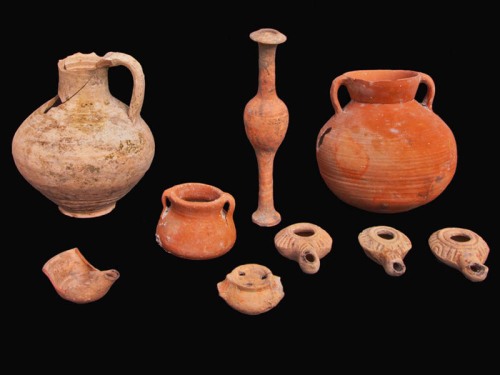'via Blog this'
Announcement was made by the Israel Antiquities Authority in Jerusalem today of the recent discovery of an inscribed “seal” bearing a shortened version of the name of God (Yahweh).
The small fired clay object was discovered from the soil collected during the recent excavations at the southwest corner of the temple mount enclosure which we mentioned here about a month ago.
A portion of the press release by the IAA reads,
Layers of soil covering the foundations of the Western Wall, c. 15 meters north of the southwestern corner of the Temple Mount, were excavated beneath Robinson’s Arch in archaeological excavations of the Israel Antiquities Authority in the Jerusalem Archaeological Garden. On top of these layers, dating to the first century CE (the late Second Temple period), was paved the Herodian street which was the main road of Jerusalem at that time. From the very start of the excavations in this area the archaeologists decided that all of the soil removed from there would be meticulously sifted (including wet-sifting and thorough sorting of the material remnants left in the sieve). This scientific measure is being done in cooperation with thousands of pupils in the Tzurim Valley National Park, and is underwritten by the ʽIr David Association. It was during the sieving [sifting] process that a tiny object of fired clay, the size of a button (c. 2 centimeter in diameter [about 3/4 of an inch]) was discovered.
The Aramaic inscription, consisting of two lines, has the word for pure, a preposition and a shortened form of the word for G-d. Jews do not write the name of God. Many of our English versions of the Bible use the word LORD for the translation of the Tetragrammaton YHWH. The short form on this object has only YH.
The excavators, Elie Shukron and Ronny Reich, explain,
“The meaning of the inscription is “Pure for G-d”. It seems that the inscribed object was used to mark products or objects that were brought to the Temple, and it was imperative they be ritually pure. This stamped impression is probably the kind referred to in the Mishnah (Tractate Shekalim 5: 1-5) as a “חותם” (seal). To the best of our knowledge, this is the first time that such an object or anything similar to it was discovered in an archaeological excavation and it constitutes direct archaeological evidence of the activity on the Temple Mount and the workings of the Temple during the Second Temple period”.
Other artifacts dating to the Second Temple period included some from the Hasmonean Period. In the photo below you will see “oil lamps, ceramic cooking pots and a fusiform juglet [the object in the top middle] that may have contained oils and perfume.” Coins minted in the days of Alexander Jannaeus (102-76 B.C.) and John Hyrcannus (135-104 B.C.) were also discovered.
The complete IAA Press Release may be read here.
Just a suggestion. Perhaps a seal such as the one mentioned above would have been used in the case mentioned by Jesus in the Sermon on the Mount.
So if you are offering your gift at the altar and there remember that your brother has something against you, leave your gift there before the altar and go. First be reconciled to your brother, and then come and offer your gift. (Matthew 5:23-24 ESV)



No comments:
Post a Comment